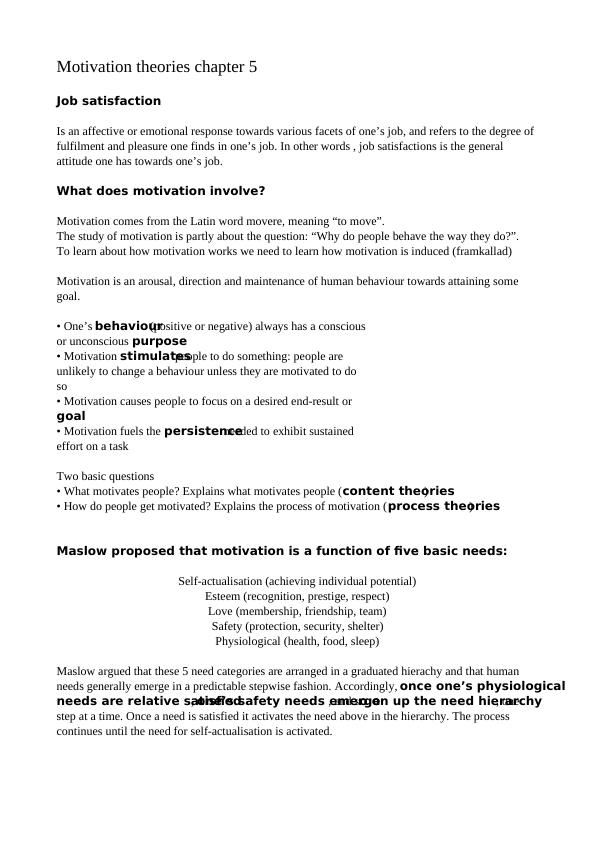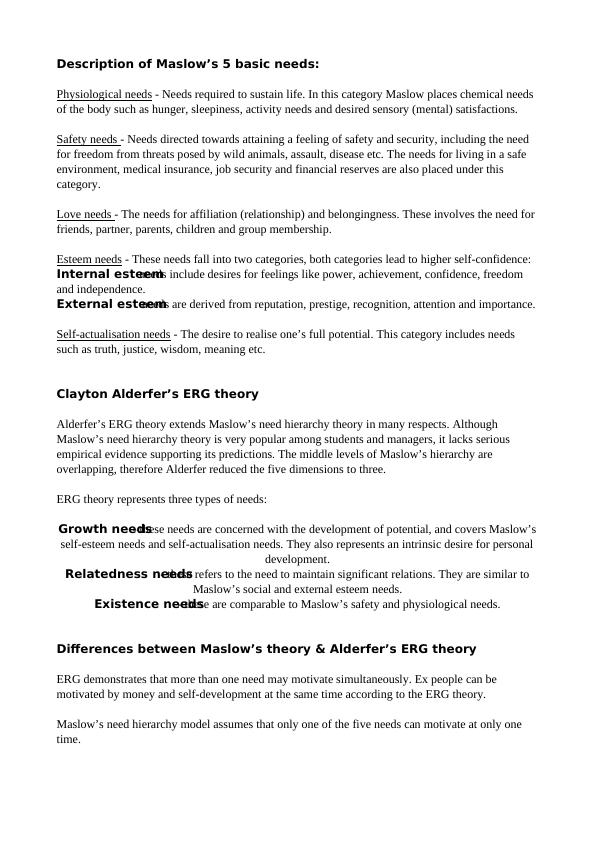Motivation Theories - PDF
6 Pages1793 Words186 Views
Added on 2020-11-10
Motivation Theories - PDF
Added on 2020-11-10
ShareRelated Documents
Motivation theories chapter 5 Job satisfaction Is an affective or emotional response towards various facets of one’s job, and refers to the degree of fulfilment and pleasure one finds in one’s job. In other words , job satisfactions is the general attitude one has towards one’s job. What does motivation involve? Motivation comes from the Latin word movere, meaning “to move”. The study of motivation is partly about the question: “Why do people behave the way they do?”. To learn about how motivation works we need to learn how motivation is induced (framkallad) Motivation is an arousal, direction and maintenance of human behaviour towards attaining some goal. • One’s behaviour(positive or negative) always has a conscious or unconscious purpose• Motivation stimulatespeople to do something: people are unlikely to change a behaviour unless they are motivated to do so • Motivation causes people to focus on a desired end-result or goal • Motivation fuels the persistenceneeded to exhibit sustained effort on a task Two basic questions • What motivates people? Explains what motivates people (content theories) • How do people get motivated? Explains the process of motivation (process theories) Maslow proposed that motivation is a function of five basic needs: Self-actualisation (achieving individual potential) Esteem (recognition, prestige, respect) Love (membership, friendship, team) Safety (protection, security, shelter) Physiological (health, food, sleep) Maslow argued that these 5 need categories are arranged in a graduated hierachy and that human needs generally emerge in a predictable stepwise fashion. Accordingly, once one’s physiological needs are relative satisfied, one’s safety needs emerge, and so on up the need hierarchy, one step at a time. Once a need is satisfied it activates the need above in the hierarchy. The process continues until the need for self-actualisation is activated.

Description of Maslow’s 5 basic needs: Physiological needs - Needs required to sustain life. In this category Maslow places chemical needs of the body such as hunger, sleepiness, activity needs and desired sensory (mental) satisfactions. Safety needs - Needs directed towards attaining a feeling of safety and security, including the need for freedom from threats posed by wild animals, assault, disease etc. The needs for living in a safe environment, medical insurance, job security and financial reserves are also placed under this category. Love needs - The needs for affiliation (relationship) and belongingness. These involves the need for friends, partner, parents, children and group membership. Esteem needs - These needs fall into two categories, both categories lead to higher self-confidence: Internal esteem needs include desires for feelings like power, achievement, confidence, freedom and independence. External esteem needs are derived from reputation, prestige, recognition, attention and importance. Self-actualisation needs - The desire to realise one’s full potential. This category includes needs such as truth, justice, wisdom, meaning etc. Clayton Alderfer’s ERG theory Alderfer’s ERG theory extends Maslow’s need hierarchy theory in many respects. Although Maslow’s need hierarchy theory is very popular among students and managers, it lacks serious empirical evidence supporting its predictions. The middle levels of Maslow’s hierarchy are overlapping, therefore Alderfer reduced the five dimensions to three. ERG theory represents three types of needs: Growth needs- these needs are concerned with the development of potential, and covers Maslow’s self-esteem needs and self-actualisation needs. They also represents an intrinsic desire for personal development. Relatedness needs - these refers to the need to maintain significant relations. They are similar to Maslow’s social and external esteem needs. Existence needs- these are comparable to Maslow’s safety and physiological needs. Differences between Maslow’s theory & Alderfer’s ERG theory ERG demonstrates that more than one need may motivate simultaneously. Ex people can be motivated by money and self-development at the same time according to the ERG theory. Maslow’s need hierarchy model assumes that only one of the five needs can motivate at only one time.

Another difference is that when the gratification of a higher-order need is blocked, the desire to satisfy a lower-level need increases. This is also known as the frustration-regression hypothesis. According to this, individuals may also move down the hierarchy. The ERG theory acknowledges that this can happen, whereas the need hierarchy model does not. Evidence about Needs Theories (explained on page 155) •Employees do not always have to satisfy their needs through their work. Higher level needs can be satisfied through other life domains such as leisure. •There is no conclusive evidence about how much time passes between the satisfaction of a lower-level need and the progress to a higher-order need •People value the same needs differently. Maslow's theory, however, is a universalistic theory which applies to everyone. As a result this theory cannot explain differences between people and between cultures •Identical rewards may satisfy different needs. A high wage may satisfy the safety need and esteem need, because it can be seen as an important indicator for appraisal and recognition at work. •Satisfaction in Maslow's theory is considered as the major motivational outcome of behaviour. However, job satisfaction does not necessarily improve work performance. •For employees with the same needs (same level in hierarchy), the motivational factors will be different because there are many diverse ways in which people may pursue satisfaction. Herzberg’s Motivator-Hygiene-Theory (sida 157 i boken) Herzberg had close links with Maslow and believed in a two-factor theory of motivation. He argued that there were certain factors that a business could introduce that would directly motivate employees to work harder (motivators). However there were also factors that would de-motivate an employee if not present but would not in themselves actually motivate employees to work harder (hygiene factors). (motivators) No satisfaction —> satisfaction Jobs that do not offer achievement, recognition, stimulating work, responsibility and advancement give no satisfaction. Jobs that do offer achievement, recognition, stimulating work, responsibility and advancement give satisfaction.

End of preview
Want to access all the pages? Upload your documents or become a member.
Related Documents
Motivational Theories and Techniques in Organizational Behaviorlg...
|7
|1638
|44
Leadership and Management: Motivational Theories and Approaches - Deskliblg...
|14
|963
|169
Content Theory of Motivation and Variables Influencing Employee Motivationlg...
|5
|1164
|329
Linkage between Alderfer’s Need Theory and Job Enrichmentlg...
|8
|1785
|116
Motivation Theories: Description, Analysis and Recommendationslg...
|10
|1870
|263
Understanding why people work: Factors, Motivation, and Strategieslg...
|9
|2135
|296
